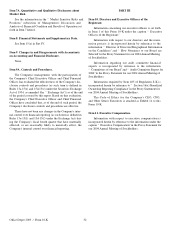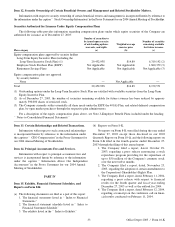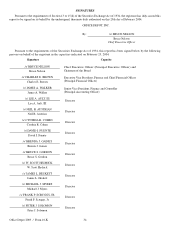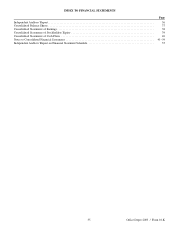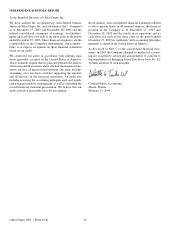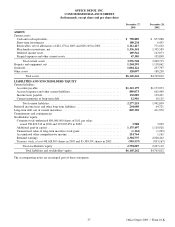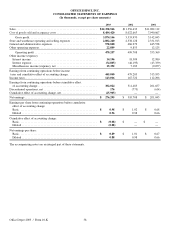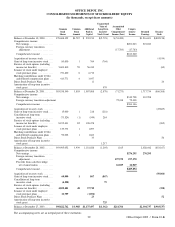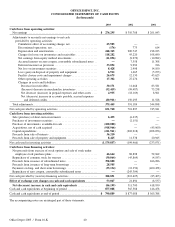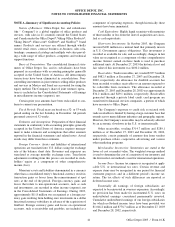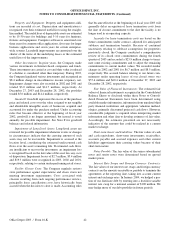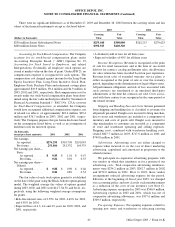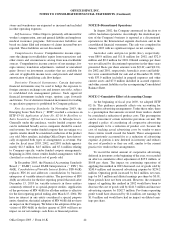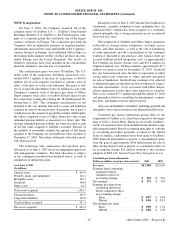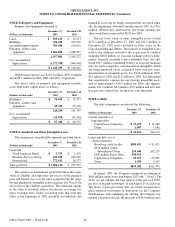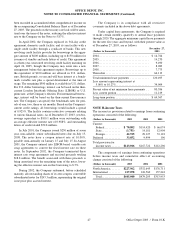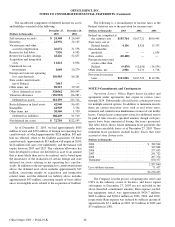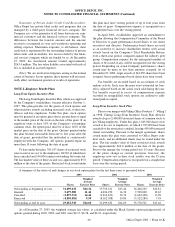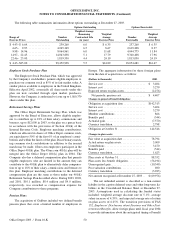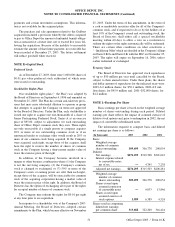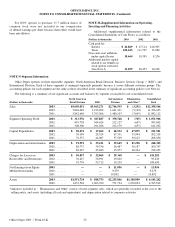Office Depot 2003 Annual Report Download - page 44
Download and view the complete annual report
Please find page 44 of the 2003 Office Depot annual report below. You can navigate through the pages in the report by either clicking on the pages listed below, or by using the keyword search tool below to find specific information within the annual report.Property and Equipment: Property and equipment addi-
tions are recorded at cost. Depreciation and amortization is
recognized over their estimated useful lives using the straight-
line method. The useful lives of depreciable assets are estimated
to be 15-30 years for buildings and 3-10 years for furniture,
fixtures and equipment. Computer software is amortized over
three years for common office applications, five years for larger
business applications and seven years for certain enterprise-
wide systems. Leasehold improvements are amortized over the
shorter of the terms of the underlying leases or the estimated
useful lives of the improvements.
Other Investments: In prior years, the Company made
various investments in Internet-based companies and funds.
These investments are carried at cost and their value is reduced
if a decline is considered other than temporary. During 2003,
the Company liquidated various investments and recognized an
$8.4 million charge in miscellaneous income (expense), net.
Impairment charges were also recorded in 2002 and 2001 and
totaled $3.0 million and $14.7 million, respectively. At
December 27, 2003 and December 28, 2002, the portfolio
totaled $5.0 million and $14.4 million, respectively.
Goodwill: Goodwill represents the excess of the purchase
price and related costs over the value assigned to net tangible
and identifiable intangible assets of businesses acquired and
accounted for under the purchase method. Under accounting
rules that became effective at the beginning of fiscal year
2002, goodwill is no longer amortized, but instead is tested
annually for possible impairment. See Note F for goodwill
balances and related information.
Impairment of Long-Lived Assets: Long-lived assets are
reviewed for possible impairment whenever events or changes
in circumstances indicate that the carrying amount of such
assets may not be recoverable. Impairment is assessed at the
location level, considering the estimated undiscounted cash
flows over the asset’s remaining life. If estimated cash flows
are insufficient to recover the investment, an impairment loss
is recognized based on the fair value of the asset less any costs
of disposition. Impairment losses of $2.7 million, $5.4 million
and $19.3 million were recognized in 2003, 2002 and 2001,
respectively, relating to certain under-performing retail stores.
Facility Closure Costs: The Company regularly reviews
store performance against expectations and closes stores not
meeting investment requirements. Costs associated with
closures resulting from such ongoing performance reviews,
principally lease cancellation costs, have historically been
accrued when the decision to close is made. Accounting rules
that became effective at the beginning of fiscal year 2003 will
generally delay recognition of lease termination costs from
the date of closure commitment to the date the facility is no
longer used in an operating capacity.
Accruals for lease termination costs are based on the
future commitments under contract, adjusted for anticipated
sublease and termination benefits. Because of continued
uncertainty relating to sublease assumptions for properties
previously closed, the Company conducted a comprehensive
review of its closed store commitments during the fourth
quarter of 2003 and recorded a $23.9 million charge to termi-
nate some existing commitments and to adjust the remaining
commitments to current market values. We recorded similar
charges in 2002 and 2001 for $6.7 million and $8.5 million,
respectively. The accrued balance relating to our future com-
mitments under operating leases of our closed stores was
$57.6 million and $60.4 million at December 27, 2003 and
December 28, 2002, respectively.
Fair Value of Financial Instruments: The estimated fair
values of financial instruments recognized in the Consolidated
Balance Sheets or disclosed within these Notes to Consoli-
dated Financial Statements have been determined using
available market information, information from unrelated third
party financial institutions and appropriate valuation method-
ologies, primarily discounted projected cash flows. However,
considerable judgment is required when interpreting market
information and other data to develop estimates of fair value.
Accordingly, the estimates presented are not necessarily
indicative of the amounts that could be realized in a current
market exchange.
Short-term Assets and Liabilities: The fair values of cash
and cash equivalents, short-term investments, receivables,
accounts payable and accrued expenses and other current
liabilities approximate their carrying values because of their
short-term nature.
Notes Payable: The fair value of the senior subordinated
notes and senior notes were determined based on quoted
market prices.
Interest Rate Swaps and Foreign Currency Contracts:
The fair values of our interest rate swaps and foreign currency
contracts are the amounts receivable or payable to terminate the
agreements at the reporting date, taking into account current
interest and exchange rates. In January 2004, we hedged a por-
tion of our fixed-rate debt by entering into a fixed-for-variable
interest rate swap for a notional amount of $100 million. We
may hedge more of our debt portfolio in future periods.
OFFICE DEPOT, INC.
NOTES TO CONSOLIDATED FINANCIAL STATEMENTS (Continued)
Office Depot 2003 / Form 10-K 42


